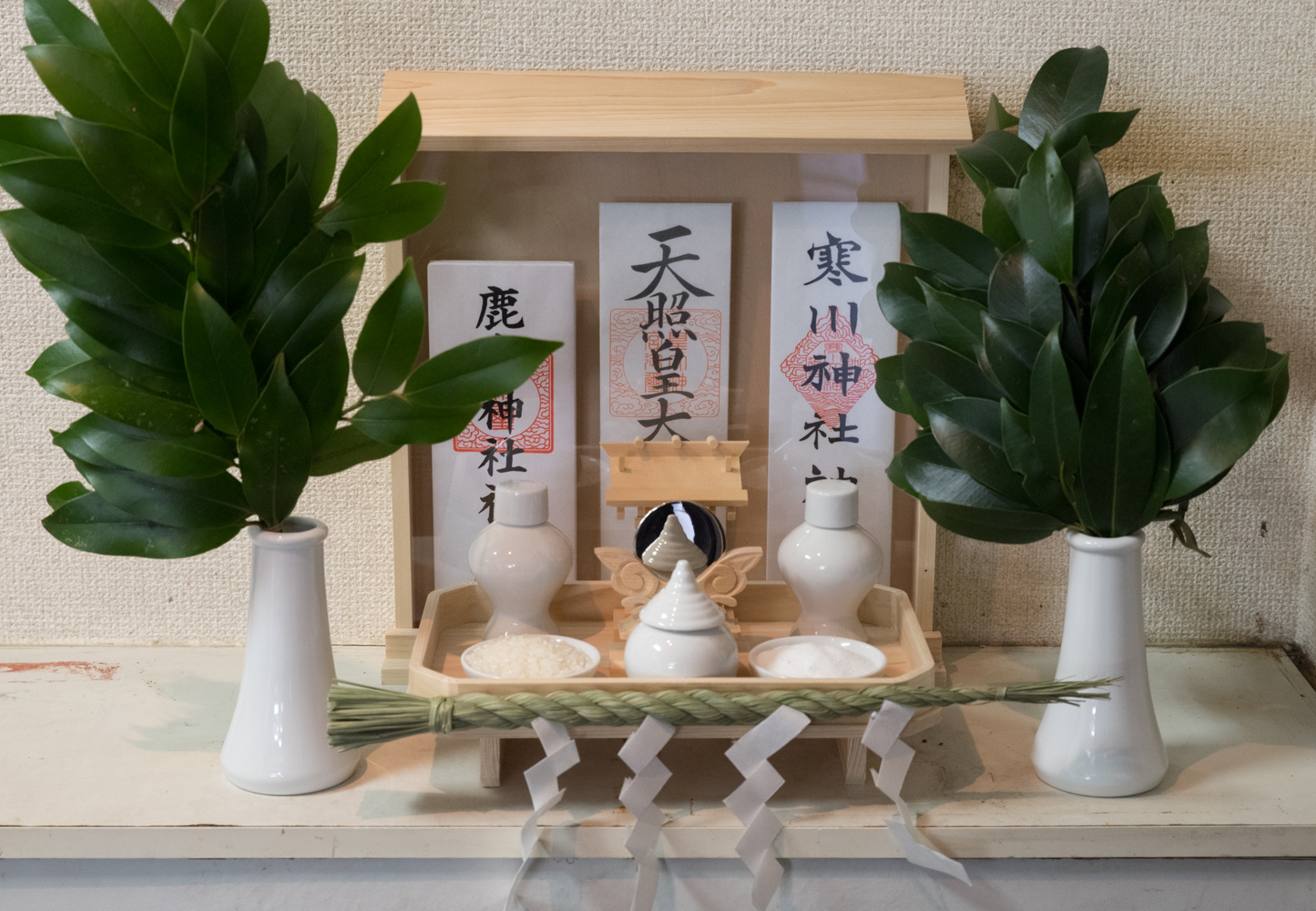
家の中に設置した簡易的な神棚ですが、あれから榊立て、神器(水やお酒を入れる容器やお米・塩を入れる皿など)、三宝、神鏡、小さなお社、しめ縄を追加して、かなり本格的な神棚になりました。家の中に神棚があると何か清浄な感じがしますし、また日々の無事を神様に感謝する習慣は良いものだと思います。
カテゴリー: Culture
お札入れ
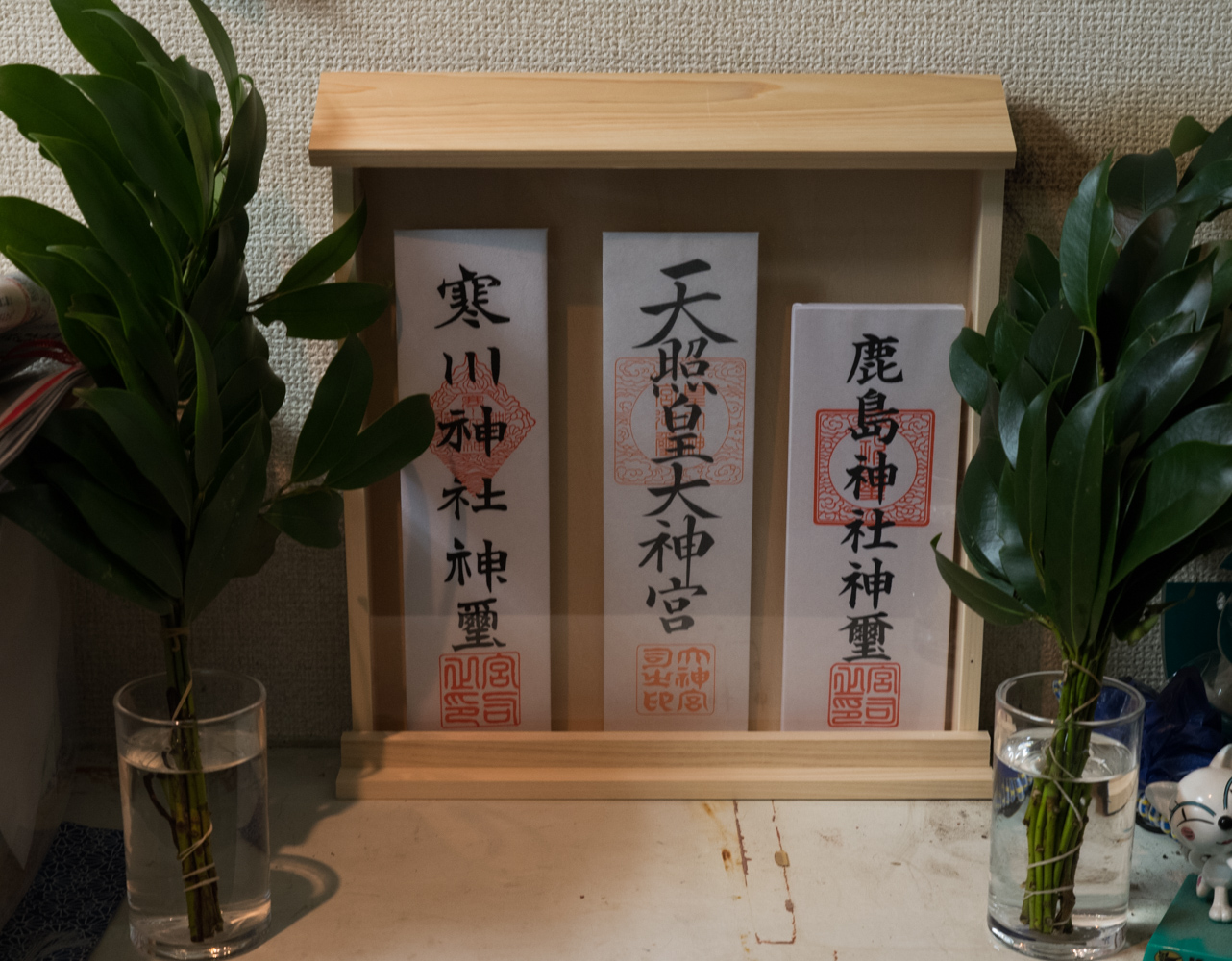 最近(ここ数年)、神社詣りが半分くらい趣味になってきていて、年間6~7回は行っていると思います。それで家に神棚を置こうかなと思いましたが、さすがに大げさなので、Amazonでお札入れがあったので、それを玄関の横の棚に置くことにしました。このお札入れは三種類のお札を入れるようになっていて、天照大御神と寒川神社の分は先日寒川神社にお参りした時にそこでいただいて来ました。残り一社は高校時代に奨学金をいただいていた福岡の宗像大社のにしたかったんですが、調べてみたら電話して頼んで、現金書留で代金を払うということで結構面倒でした。で他のを探したら鹿島神宮のがWebから簡単に申し込めたのでそれにしました。(代金は郵便振替)鹿島神宮の祭神の建御雷神は、地震避けの神様(大鯰を要石で抑えている)なので、丁度いいかなと思いました。
最近(ここ数年)、神社詣りが半分くらい趣味になってきていて、年間6~7回は行っていると思います。それで家に神棚を置こうかなと思いましたが、さすがに大げさなので、Amazonでお札入れがあったので、それを玄関の横の棚に置くことにしました。このお札入れは三種類のお札を入れるようになっていて、天照大御神と寒川神社の分は先日寒川神社にお参りした時にそこでいただいて来ました。残り一社は高校時代に奨学金をいただいていた福岡の宗像大社のにしたかったんですが、調べてみたら電話して頼んで、現金書留で代金を払うということで結構面倒でした。で他のを探したら鹿島神宮のがWebから簡単に申し込めたのでそれにしました。(代金は郵便振替)鹿島神宮の祭神の建御雷神は、地震避けの神様(大鯰を要石で抑えている)なので、丁度いいかなと思いました。
行きつけのスーパーで榊を売っていたので、取り敢えず略式ですがお供えです。一応Amazonでちゃんとした白い容器をポチっています。
(念のため。私はかなりの数の聖書のコレクションを持っています。イエス・キリストを「人生の教師」(ゲーテの表現)として尊敬していますが、旧約聖書に出てくる神様については、私はまるで信じる気になれません。私は別にまた神道イストという程のものではありませんが、自然と一体化するような神道の考え方が好きです。)
New Year’s traditions in Japan
The following is my essay that I wrote as an assignment for an English school AEON:
Topic: New Year’s traditions in Japan
Style: Casual
There were a bunch of rituals, ceremonies, and customs related to New Year’s holidays. Most of them are currently lost in many families, but there is one area where a long tradition is still vital: food. The most important special food for a new year is mochi, or rice cake. Mochi is made from a special type of rice that is stickier than the usual type. We steam that rice and put it in a stone bowl and hit it by wooden beetles for say, 10 to 15 minutes. The rice is crushed enough to become like a pudding. Then we pick some apart and make it round (the way in the western part of Japan) or cut it with a big knife (the way in the eastern part of Japan). While the form of mochi in the western part of Japan is round, it is rectangular in the eastern part. The round form was the original, but the eastern type rectangular form was introduced to cope with increased population in Edo (the former name of the Tokyo city) to save time. Since I was born in Yamaguchi prefecture that is located in the west end of Honshu island. I was surprised very much when I saw rectangular mochi in Tokyo for the first time.
There are several ways to cook and eat mochi, but the most typical and important dish to use mochi is zoni, special soup with mochi. Zoni is prerequisite for the first three days of the New Year for breakfast. I just mentioned the difference of the form of mochi, but there are tens of hundreds of ways to cook zoni. When a newly married couple, each coming from different areas in Japan, holds a New Year ceremony together for the first time, one of the most troublesome things is how to cook zoni. Each has a completely different image for zoni, and since zoni is a very special and important dish for a New Year, it may cause a lot of trouble between the couple. Not mentioning the form of mochi, there are also two ways to prepare mochi for zoni: to bake or to boil it. There are also several types of soup such as soy source based, soy bean paste (miso) based, and in some limited area they use ‘sweet’ soup using red bean paste.
When I was living in Tokushima, there was an exhibition in a local museum regarding the types of zoni in the Tokushima prefecture. Since Tokushima (Awa) was governed by Hachisuka family came from Aichi prefecture, there are some families that use rectangular mochi while round mochi is popular in Tokushima which locates in the western part of Japan. There were actually almost forty or fifty different types of zoni in the prefecture. One thing that surprised me was that there are some people living in deep mountain area who eat soba noodle instead of zoni since they cannot plant rice because of cold weather.
Now, I usually spend New Year holidays travelling. It is always interesting to try a new type of zoni in different areas.
Cell phones and social etiquette
The following essay is what I wrote as an assignment of an English school AEON.
Topic: Cell phones and social etiquette
Style: Formal
Among many alleged manners for cell phones or smartphones, the most vocal one in these days might be “do not use your cellphone/smartphone while you are walking on the street”. It is absolutely true that looking at the screen of a cellphone/smartphone during your walk is quite dangerous not only for you, but also for others whom you may jostle. Some of smartphone applications, however, require users to watch the screen while they are walking. The most typical one is Google Map. Many people (including myself) use the app to find destinations when they are lost in unfamiliar areas. Some may argue that we should use the “vocal guidance” function so that we do not need to look at the screen. For many others, however, it is inevitable to look at the screen even with some vocal guidance since the app is named “map”. And a map is to look at while we are walking. In the past, when we had no cellphone/smartphone, nobody said that we should not look at a paper map while we were walking. The difference between the old information system and the new one is, just the number of people who use it. People did not always have maps in the past, but now most of them have smartphones and they use them almost all the time while they are awake.
From this example, we can argue that we should think more how to solve the addiction to smartphone than to expect good manners for smartphones. For many young people, the first thing to see in the morning after they woke up and the last thing to see before they fell asleep are the same thing, their smartphones. When I travelled in China in last September, what shook me most was the fact that many young engineers with whom I had a lunch one day started to check their smartphones as soon as they finished eating. At this point of change in personal behavior, we should intensively study potentially negative impacts to human health for both body and mind.
As a conclusion, smartphone addiction is quite a serious problem and to consider good smartphone etiquettes is quite useless without thinking of possible solutions for this addiction.
Childhood
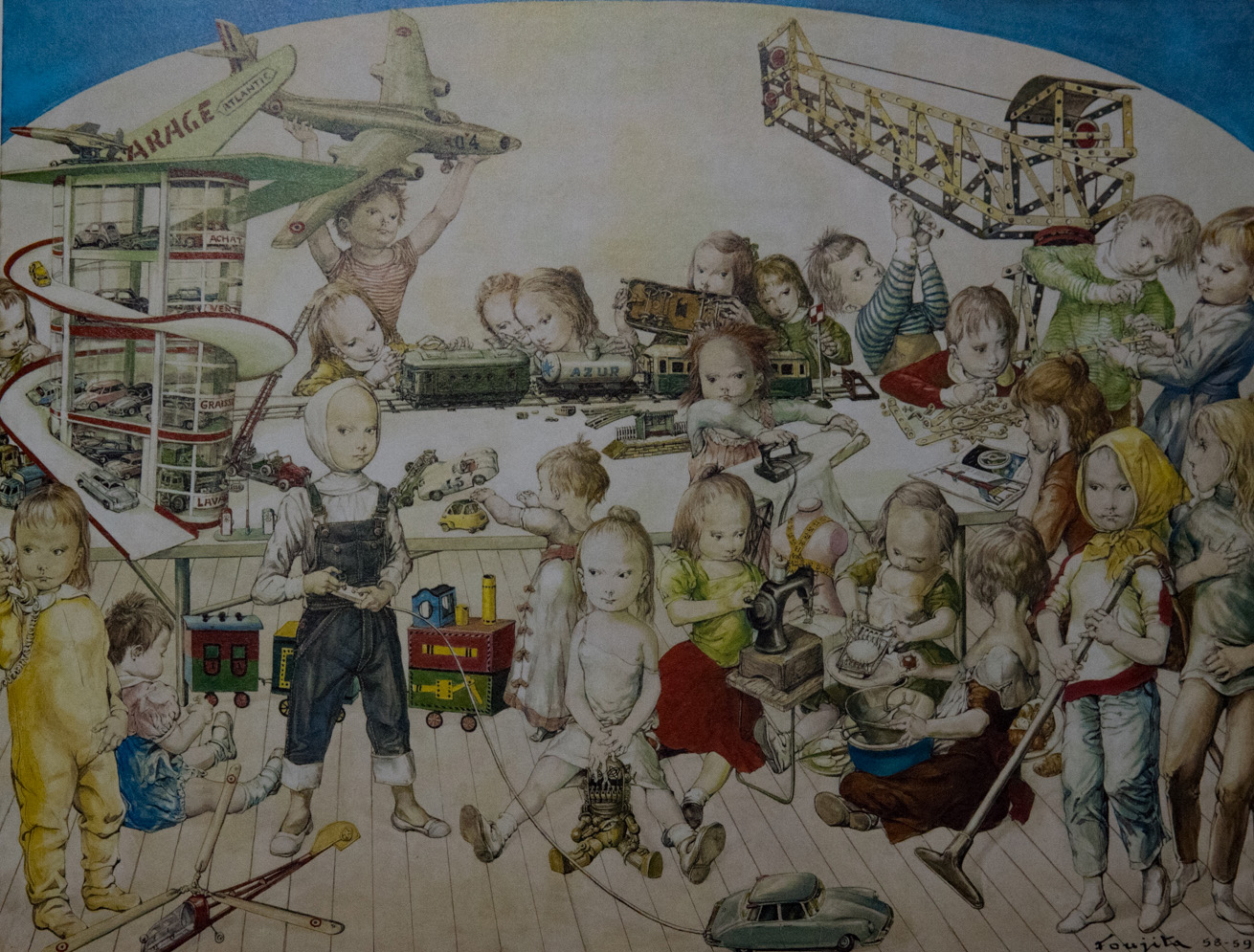 The following is an essay that I wrote as an assignment for an English school AEON:
The following is an essay that I wrote as an assignment for an English school AEON:
Topic: Childhood
Style: Casual
Let me start with one picture of Tusguharu Foujita (Leonard Foujita) that I found in his exhibition held in September:
The picture was drawn in 1958 and 1959 and was titled “The Machine Age”.
It may draw nostalgic reaction from people born in around that time. (I was born in 1961.) Most toys shown in this picture are quite familiar to me, such as tin toys (I had one of Astro Boy at home), remote-controlled cars, toy cars (in Japan they were called “minicars”), HO scale train models, and so on.
As the title of the picture shows, the 1960’s were really “the machine age”, and Japan was just in the midst of high-speed economic growth. In my childhood, I believed so many things were common knowledge without any doubt such as:
(1) Economics will grow eternally.
(2) No music, no life (sorry Tower Records)
(3) Human beings will soon reach Mars, Jupiter, or Saturn.
(4) Flying cars will be available within several decades, at the latest by the 21st century.
(5) Animation films or dramas are mostly Sci-Fi based.
(6) Students are attending universities not to study, but to join political movements or some protests.
(7) The whole world will perish soon with nuclear weapons.
All of these expectations were revealed to be untrue, in the 1970’s or later. (The last one was fortunately proven to be not true.) I gradually started to think that the 1960’s were actually very unique, strange, but energetic periods that are completely different from the 1970’s, 80’s, or later. I also knew that there had been some “spiritual” people claiming that the 1960’s had been the start of “new age”.
I am currently addicted to watch Sci-Fi based old TV dramas from the 1960’s. I have so far bought DVDs or Blue-rays: the four series of Irwin Allen dramas (Voyage to the Bottom of the Sea, Lost in Space, The Time Tunnel, and Land of The Giants), two of Gerry Anderson’s (Thunderbirds, UFO), and the original series of Star Trek by Gene Roddenberry. By watching them, I can now understand how I was brainwashed or imprinted during the 1960’s as a then kid. In 2018, very few people care about cold war (except concerns for the start of “new” cold war with China), only limited people talk about possible “doomsday”, but such topics were quite seriously considered in many of the above dramas.
Honestly to say, I’m living 50% of my life still in the 1960’s. You can check out any time you like, but you can NEVER leave!
包丁研ぎの顛末
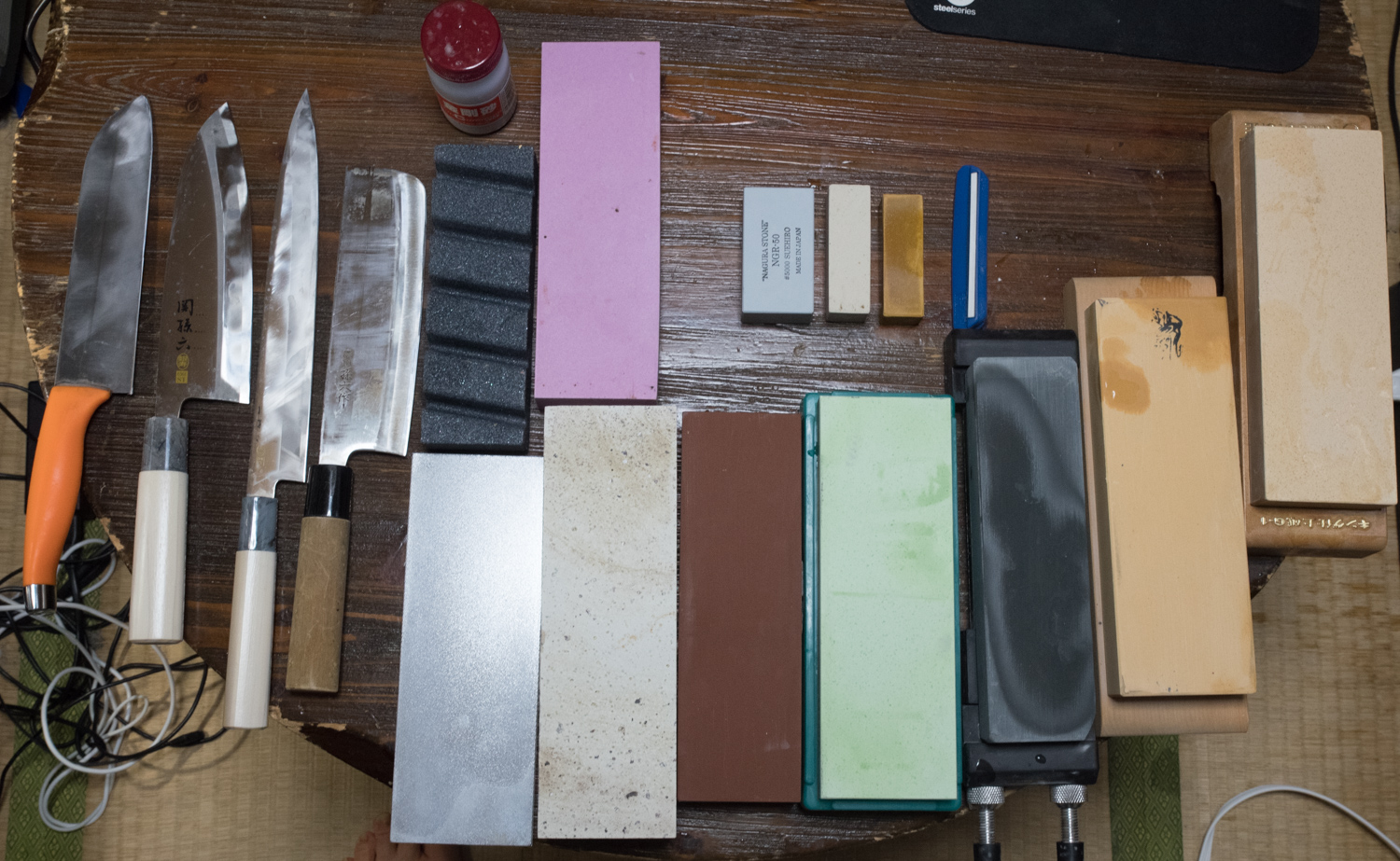 最近のマイブームはラズベリーパイと包丁研ぎです。私の趣味の特徴はともかく「蒐集癖」で、包丁研ぎもご覧の通りの有様。もっともちょっと前から荒砥(#200)・中砥(#1000)・仕上げ砥(#4000)と砥石の面直し用砥石と金剛砂(研磨用の人造ダイヤモンドの粉)は持っていました。そこに更に中砥が2種類、仕上げ砥が2種類追加、面直し用も1種追加になっています。三徳包丁と両刃の菜切り包丁(探したら以前使っていたのが出てきました)については、「スーパートゲール」のお陰で、ちゃんと角度一定で研げていますが、他の和包丁についてはまったく自信なく、取り敢えず練習のために出刃と柳刃を買ったようなものです。(徳島在住時代釣りをやっていたので出刃と刺身包丁は持っていましたが、錆び付いていたのでステンレスのを買い直しました。)これだけ揃えたのだから、では毎日自炊するかといえば、それはしないのが私らしいです。典型的な男の料理というか。これらの砥石の中ではこの所毎日使っているのは一番右のキングゴールドの#8000です。この砥石を、ほとんど包丁の片面を研いだら、すぐ面直しして研いでます。
最近のマイブームはラズベリーパイと包丁研ぎです。私の趣味の特徴はともかく「蒐集癖」で、包丁研ぎもご覧の通りの有様。もっともちょっと前から荒砥(#200)・中砥(#1000)・仕上げ砥(#4000)と砥石の面直し用砥石と金剛砂(研磨用の人造ダイヤモンドの粉)は持っていました。そこに更に中砥が2種類、仕上げ砥が2種類追加、面直し用も1種追加になっています。三徳包丁と両刃の菜切り包丁(探したら以前使っていたのが出てきました)については、「スーパートゲール」のお陰で、ちゃんと角度一定で研げていますが、他の和包丁についてはまったく自信なく、取り敢えず練習のために出刃と柳刃を買ったようなものです。(徳島在住時代釣りをやっていたので出刃と刺身包丁は持っていましたが、錆び付いていたのでステンレスのを買い直しました。)これだけ揃えたのだから、では毎日自炊するかといえば、それはしないのが私らしいです。典型的な男の料理というか。これらの砥石の中ではこの所毎日使っているのは一番右のキングゴールドの#8000です。この砥石を、ほとんど包丁の片面を研いだら、すぐ面直しして研いでます。
包丁の切れ味
包丁研ぎ
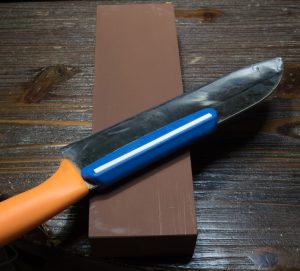 家で包丁を使うのは、今は基本的にリンゴ・柿・梨などの果物の皮を剥くときだけですが(私は子供の時亡母に教わったし、実際に小学生の時は朝食を作っていたりした関係で、それなりに果物の皮を剥くのはそこらの若い女性より多分うまいです)、何故か包丁の切れ味には凝っていて、現在砥石3種(荒砥、中砥、仕上げ砥)と、その砥石が平らでなくなった時に使う砥石を研ぐ砥石と、その時砥石に振りかける人造ダイヤモンドの粉まで持っています。
家で包丁を使うのは、今は基本的にリンゴ・柿・梨などの果物の皮を剥くときだけですが(私は子供の時亡母に教わったし、実際に小学生の時は朝食を作っていたりした関係で、それなりに果物の皮を剥くのはそこらの若い女性より多分うまいです)、何故か包丁の切れ味には凝っていて、現在砥石3種(荒砥、中砥、仕上げ砥)と、その砥石が平らでなくなった時に使う砥石を研ぐ砥石と、その時砥石に振りかける人造ダイヤモンドの粉まで持っています。
と道具に凝るのはいいですが、なかなか「丸研ぎ」といわれる角度が不均一な研ぎから脱却出来ていません。要するに研ぐときに刃物を砥石に当てる角度を一定にする、ということです。この角度は万能包丁の場合15°くらいみたいですが、私はこの角度に保ってくれる当て板みたいなのがないかと思って探してみましたが見つかりませんでした。素人の「丸研ぎ」でも、まったく研がないよりは切れ味は向上しますが、結局その切れ味が均一ではなくムラが出ます。Webで調べると、丸研ぎにならないこつは、
(1)包丁を砥石に対し斜めに当てて、包丁と砥石が一度に接触する部分を増やす。
(2)あわてずに、ゆっくり角度を保つようにして研ぐ
(3)砥石がすり減っている場合にはまっすぐに面を直す(このために砥石を研ぐ砥石が必要です。)
(3)については、昔「味いちもんめ」という漫画で、自転車の後ろに紐で砥石をくっつけて引っ張って、アスファルトの面で砥石を研磨する、というのが出てきましたが、その方法は危険ですし、また砥石が均一に平らになる保証もありません。
ということで、今回念のためもう一度角度を保つ当て板みたいなものがないか探してみたら、何と複数の会社から出ていました。早速Amazonで注文して取り寄せました。早速使って研いでみましたが、なかなかいいです!角度そのものは私が思っていたよりも大きい感じでした。治具が砥石とすれて邪魔になるんじゃないかと思われる方があると思いますが、接触する部分はセラミックになっていて簡単にすり減らないようになっています。また研ぐ時に邪魔になる感じもあまりありません。却って束に近い方を研ぐ時はこれまで束が砥石に当たってうまく研げませんでしたが、この治具付けるといい感じになります。
ただ、この治具はあくまでも一般的な洋包丁の万能包丁向けだと思います。刃も薄く、また刃の高さもあまりない包丁などをこれを使って研ぐと角度が正しくなくなると思います。
Food safety
The following essay is what I wrote as a writing assignment of an English school AEON. The title this time is “Food Safety” and I described three notorious incidents in Japan.
Topic Food safety
Style Formal
We eat to live, not we live to eat. Food is, however, one of the most essential parts for our health. In the traditional thought of oriental medicine, foods occupy the crucial part of medication. In Japan, we believe that we can drink rather safe water and eat mostly safe foods. Despite the alleged fact that Japan is the safest country in the world for water and foods, it does not mean that Japan is 100% free from risks caused by poisonous water or foods. Let us look at three notorious examples happened in Japan from the late 1950’s to the present:
(1) Morinaga Milk arsenic poisoning incident (1955)
Dry milk corrupted by arsenic produced at the Morinaga’s Tokushima factory killed 130 infants and 12,044 suffered from arsenic intoxication for a long period. This is practically the first incident in Japan where the safety of food was strictly reviewed and the related consumer protests were highly activated. Because this incident happened during the country’s rapid growing period, the then government tried to protect Morinaga rather than to defend the victims and actually oppressed the related consumer activism. In 1969, 14 years after 1955, a professor at Osaka university found that the victims still suffered from aftereffects and it stirred up strong boycott campaign in all over Japan. Morinaga finally accepted its responsibility and closed its Tokushima factory in 1970.
(2) Kanemi oil symptoms (Yusho) incident (1968)
Because of edible oil contaminated by PCB (polychlorinated biphenyl), more than 14,000 people suffered from skin and visceral disorder. Some pregnant mothers gave birth to so called “black babies” and it stunned people all over the world. The oil was produced by Kanemi Warehouse company and PCB that was used as a heat medium in the production line leaked from wrongly allocated pipes and was mixed with edible oil. PCB changes to dioxins once heated and caused many health troubles for the victims. The production and import of PCB were prohibited in 1975, although it had been until then widely used as a good insulating material.
(3) Yukijirushi mass food poisoning incident (2000)
14,780 people who drank Yukijirushi’s low-fat milk described symptoms such as diarrhea, nausea, or abdominal pains. Despite the fortunate fact that no one died, it was the biggest incident related to food safety in Japan. In this case, the reaction of Yukijirushi was quite bad and what the CEO said in an interview was harshly criticized. (He said that he has not slept at all by the incident). Although Yukijirushi was one of the biggest food related companies at that time, it lost its market share in a very short period and it was finally absorbed by another company.
The current relatively safer status for food was built upon such harsh experiences. Some weekly magazines now frequently report the risk of foods imported from China. We can be sure that China will also experience such incidents in the near future. (Please note that many visitors from China to Japan often buy Japanese dry milk including Morinaga’s claiming that they are much safer than Chinese companies’ products. It sounds very ironic.)

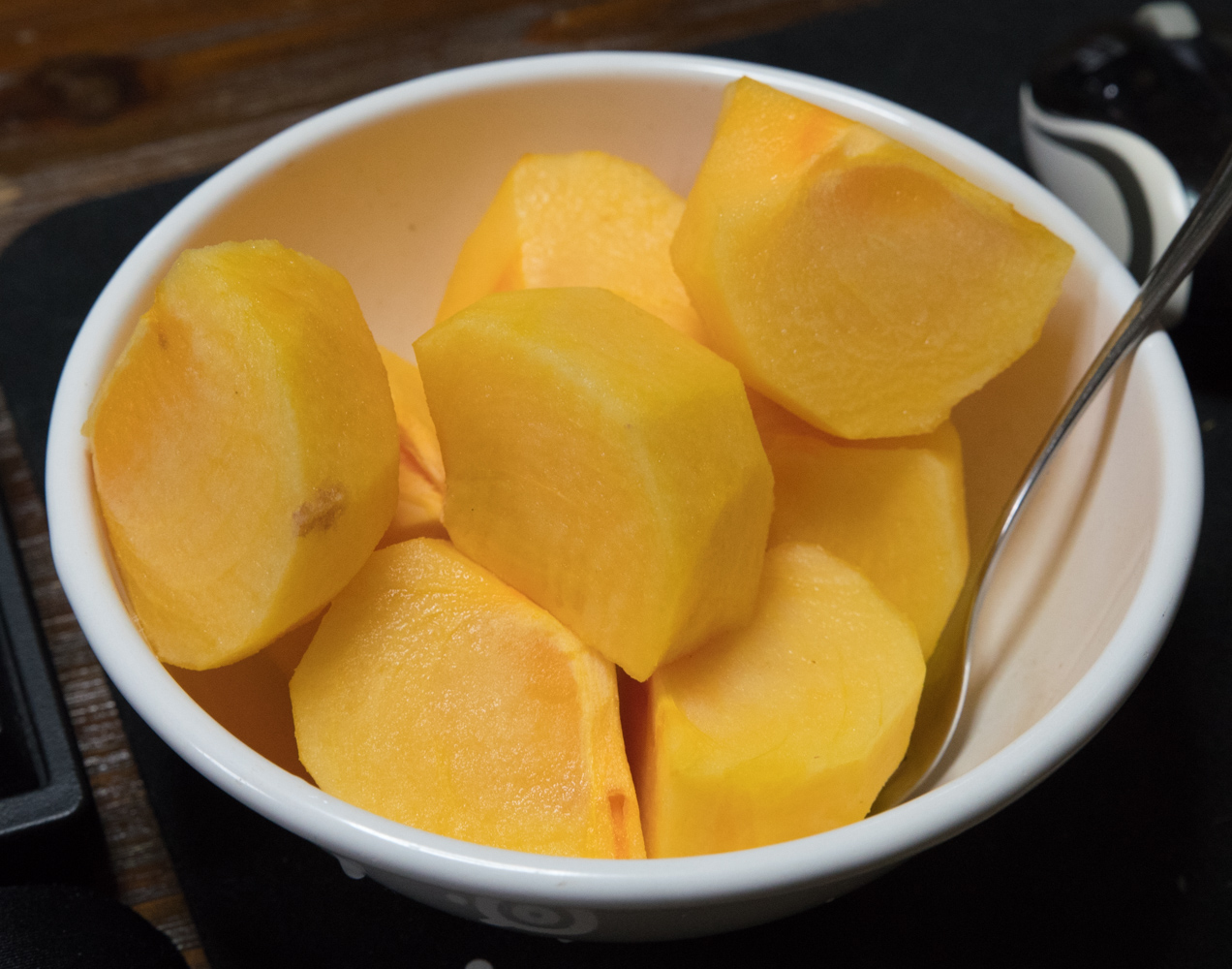
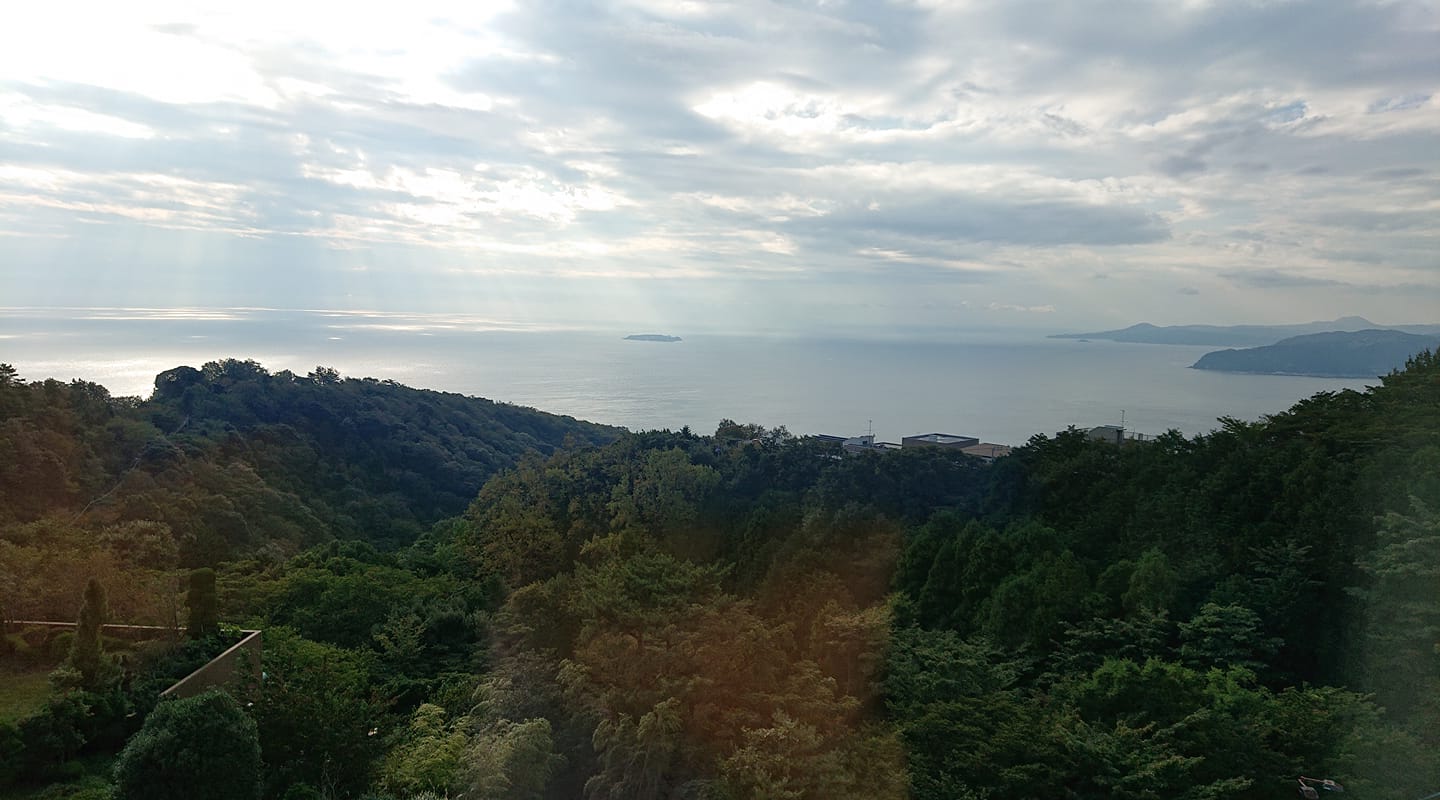
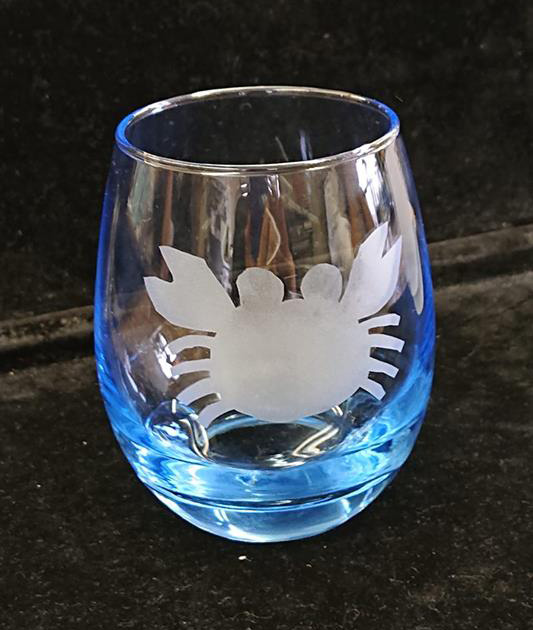 25年ぶりくらいに職場旅行に行ってきました。私の会社の中では今いる開発部隊だけが今でも職場旅行をやっています。場所は熱海市の伊豆山で、健康保険組合の保養所です。ご覧のように窓から見える景色は中々です。一泊して翌日に、熱海市内でガラスのサンドブラスト加工の体験をしました。
25年ぶりくらいに職場旅行に行ってきました。私の会社の中では今いる開発部隊だけが今でも職場旅行をやっています。場所は熱海市の伊豆山で、健康保険組合の保養所です。ご覧のように窓から見える景色は中々です。一泊して翌日に、熱海市内でガラスのサンドブラスト加工の体験をしました。